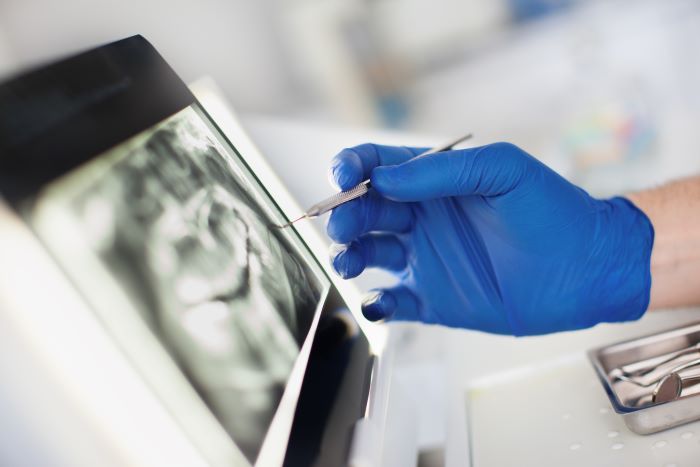Benefits of Digital X-rays

Imaging in dentistry provides dentists with a potent tool to accurately identify and treat many dental and mouth diseases. Because patient protection is one of our office's highest priorities, we consistently employ the most advanced technology. The conventional approaches used in the past to view specifics about oral wellness have been supplanted by digital dental x-rays as an alternative.
When older, more conventional X-ray procedures were employed, several complications arose, including difficulties relating to the amount of time spent waiting, time spent preparing, the time for the film to be processed, etc. Thus, digital radiography has genuinely brought about a revolution not just in the process of taking dental X-rays but also in the way that professional dentists go about their work.
In today's world, most dentist clinics only provide patients with digital x-rays. This lessens the risk of legal action against the dentists and makes the visit more pleasant for the patient. Compared to conventional radiography, digitized dental x-rays are more cost-effective, faster, precise, and safer. Additionally, digital x-rays make it possible to save documents about your dental health more quickly.
Digital x-ray pictures, in contrast to their analog counterparts, are saved in a computer, which has an almost infinite capacity for data storage. Because of this, you can switch dentists without some of your health information being lost in the process.
How does digital X-ray technology work?
Traditional dental X-rays and digital radiography follow processes that are pretty comparable in many respects. The process of digital radiography involves inserting a sensor into the patient's mouth, which helps to capture pictures of the patient's teeth. The answer to this question is where the divide sits between traditional X-rays and digital X-rays. The digitized sensor is a device linked to a computer, even though it resembles the film used for conventional X-rays.
The equipment takes the photos and then displays them in real-time, where you and the dentist may see them. To recap, computer technology's ability is combined with the capabilities of sensing devices and extremely brief exposures to radiation to create digital radiography. Rather than printed out on film, the picture develops practically immediately after the sensor is inserted inside the mouth and projections to a computer display. This process eliminates the need for film.
The Advantages of Using Digital X-Rays
Dentists rely on x-ray pictures to evaluate and diagnose dental problems since these disorders cannot be noticed simply by looking in a patient's mouth. And in the same way that films and video recorders shifted from traditional film to digital film, the computerized x-ray image is becoming the norm for dental clinics around the nation. These include dental practices in prominent locations like dentists in Las Vegas or some Summerlin dentists.
When you go in for your subsequent dental X-rays, you don't need to worry about the potential side effects since they are risk-free and won't harm your body. Visiting a dental clinic in your area that makes use of digital radiography comes with several significant advantages, including the following:
Radiation exposure is reduced.
Patients often list radiation as one of their primary worries. Compared to film imaging, the amount of radiation exposure to the patient during digital imaging is 70 percent lower. The use of digital x-ray imaging is entirely risk-free. The radiation dosage given out during a digital dental x-ray is .005 Millisieverts, far lower than the amount of radiation that an individual is exposed to daily.
Dentists continue to use lead aprons even though the radiation dose of digital x-rays is far lower than that of traditional x-rays. In addition, digital x-rays often need fewer retakes owing to difficulties such as inadequate exposure, improper posture, or other problems, which eventually result in a reduction in the total amount of radiation exposure.
The images are available right away.
In contrast, an expert must process the film in a dark room for several minutes before being examined. Still, dentists may view digital photographs almost immediately after being shot using a digital camera. Because the results are immediate, a diagnosis may be made much more quickly. There is never any waiting when digital radiography is used. After the pictures have been taken, they may be seen almost immediately on a screen attached to a computer. This assists patients and dentists save time, but it also helps dentists who are doing dental operations and require information simultaneously.
Optimized Images
It is feasible to swiftly improve x-ray pictures using the software supplied with digital radiography equipment, which is effortless. It is possible to make adjustments to the image's scale, contrast degree, or brightness level, all of which, depending on the circumstances, can make an issue simpler to see and locate. The development of digital imaging technology has made it possible to achieve higher contrast and more excellent visualization.
When patients examine their x-rays with a dentist, it also makes it simpler to identify any existing issues. Because of its high resolution and precision, the dental scanner can provide the dentist with more essential data. Computers can provide pictures of the teeth and the gum and other oral tissues and images of the teeth.
Help Save Money and Effort
Digital x-rays may be used in early detection approaches, which helps reduce the number of necessary treatments. As a consequence of this, patients have the opportunity to save costs and save time by preceding more intrusive procedures. In the long term, the cost of digital radiography is lower, it is better for the environment, and it results in less chemical waste, even though the initial investment in digital imaging technology may be more costly.
Comfortable Procedure
One of the reasons patients feel uneasy about a dentist visit is the many strange sights and scents that you will encounter there. If this is the case, you will be relieved to learn that digital imaging methods provide a far more pleasant experience than their analog counterparts. You do not need to cover yourself with as many layers of lead protective covers as you would during a typical x-ray. Lengthy procedures of scanning your teeth or biting down for extended periods are gone since digital radiography uses a sensor. This eliminates the need for those steps.
Environmentally Friendly
Digital x-rays have an opportunity to reduce pollution since they do not need the use of chemicals for film processing. The creation of digital photographs does not need the use of any chemicals that dentists would otherwise discard. The process of developing the film in radiological imaging does not need the use of any chemicals.
Conclusion
At Willow Springs Dental, the staff is dedicated to providing our patients with the most advanced dental technology in the industry. Please contact our office whenever convenient for you to get more information about the advantages offered by the recent advances in technical capability.



